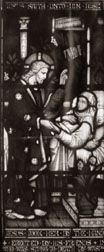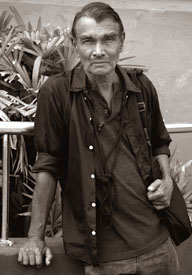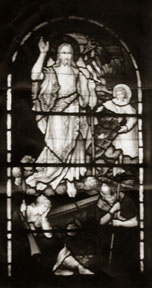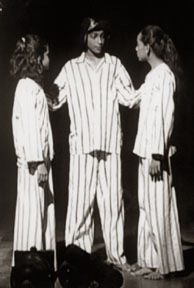|
dailynews |
|
|
|
|
|
OTHER LINKS |

|

|

|
|
|
|
|
ARTS AND MEN: He stands out among the many teachers of drama and theatre of today. And, he is resolutely and formidably alone. But, he sticks to the Wayside Theatre Troupe he pioneered some three decades ago.
There are many who value the avant-garde artiste in him.
But are they willing to give him the high profile he deserves? Is it because his idea of an activist theatre associated with liberation struggles of the people of Sri Lanka which he has been advocating still anathema to the elitist view of theatre and drama in our society?
The Wayside Theatre Troupe pioneered and led by Gamini K. Hattetuwegama completes thirty two years this year.
It was on Poson Poya Day in 1974 Wayside Theatre Troupe had their debut at Anuradhapura Railway Station.
Since then, he has been conducting theatre training workshops all over the country with a variety of groups, producing many experimental plays, which are radically oriented and political.
Wayside Theatre Troupe remains the longest, continuous activist theatre troupe associated with the liberation struggles of people of Sri Lanka.
In 1975, when FAO (Food and Agriculture Organization) had its international conference in Colombo, the troupe produced their play 'Loka Ahara Sammelanaya' which created a sensation when the play was enacted at the dinner venue for the delegation.
The play was a strong critique of the policies of the rich nations towards the world food policy. The play received the attention of the international media. Among those who reviewed the play was the late Dr. Ediriweera Sarachchandra.
In the field of drama and theatre, he has been a teacher, playwright, producer, director, actor and critic.
As a pioneer in creating and spreading the theatre workshop system, he has been augmenting his teaching task by trying to build critical minds.
"It is difficult to teach to think critically. And, it is more difficult to transform both the heart and mind. But it is necessary, he says.
In the sixties, he wrote a column titled 'Of Arts and Men' to the Ceylon Daily News. Then he was a lecturer in the English Dept. at Peradeniya University.
Renowned as a film critic, in 1967 he was unanimously elected President of the Film Critics and Journalists' Association.
Presenting citations at film awards, a practice started by Film Critics and Journalists Association, was spearheaded by Gamini Hattetuwegama. He is the first to write citations for awards.
Joining Ranga Shilpa Shalika - at Lionel Wendt, the drama school as a teacher of drama at the invitation of Dhamma Jagoda, in the mid sixties, was a turning point in his career.
Though he did not stay with Dhamma Jagoda for long, during the few years, he got some space to try out his radical concepts of theatre, with the Ranga Shilpa Shalika students.
As a lecturer of English Drama and Theatre, at Peradeniya, he was in contact with the English educated elite at Peradeniya. By then, a quite well-known actor in the English theatre, he acted in the plays of Ernest Macintyre, and co-acted with personalities like Irangani Serasinghe.
But, slowly he was turning his back on English theatre which was becoming 'elitist'. 'Even today our ideas cannot be liberative in the English Theatre' he believes.
Leaving Ranga Shilpa Shalika in 1973, he wanted to try out his own thing - a radical theatre which plays a strong political role, a theatre which is critical of many unhealthy systems of society, a changed concept in drama and theatre - a change in script - construction - and voice of the play.
He started a non-formal workshop with the help of two undergraduates in the then Kelaniya Campus, Osmand Bopearachchi, and Sarojini Jeganayagam. The first try-out of the group was a 3 minute play 'Ranga Kebali Saha Sangeetha Sochchamak'.
Thus the 'Theatre on the road' was launched. At present they have produced and enacted more than fifty plays.
In 1990 he joined Lakshman Fernando and Gamini Fonseka Edirisinghe to write a script for 'Hamlet' in Sinhala. Hailed as one of the best translations of Shakespeare, the play was co-directed by Gamini Hattetuwegama and Haig Karunaratne. In the play Gamini H. acted as Claudius.
In recent times, he produced several plays on certain modern day human dilemmas. 'Dead Mobiles' depicts the indifference in human society. 'Mr. K. and Cianide' 'killer' are two others.
How was it possible for the Wayside Theatre Troupe to survive? It is sheer commitment and sacrifice. And, the polemical nature of this genre of art.
The troupe doesn't get funds from any individual institution or State organization, because their objectives are not commercial.
In spite of little more than three decades in existence, it is somewhat eclipsed in society.
One reason, and may be the biggest reason, is the elitist attitude towards street theatre.Further, like other genres of art today Street Theatre too suffers from a lack of proper critical tradition.
In spite of all the teaching on drama and theatre, in universities, and workshops there is no critical exploration of the subjects. "There are critics who write reviews without seeing plays or films.
Today we have a fairly lively theatre, but no critical reviewing", he says.
Today there are about 50 street theatre troupes in the country.
This quantitative development doesn't necessarily mean qualitative development."
A good example of the absence of qualitative development is the attitude of certain people towards Wayside Theatre. He related an incident which the troupe experienced when they were enacting the play 'Vendesiya' (Auction) on an International Women's Day.
The police who came and disrupted the play advised the troupe. "Go and get a place like BMICH.
Who have dramas enacted on the street?" There were many instances when he had to be in the police lock-ups, while they enacted protest plays.
One such incident was when the non-academic staff of Peradeniya University went on strike in 1989.
On special days like International Women's Day or Labour Day, Wayside Theatre troupe always tried to introduce a play in connection with the general theme.
This was later followed by many theatre groups.
The Stained Glass - technique of painting with light
|
|
PAINTINGS: The human being has an insatiable mindset to be different from the others and persuaded him to be in pursuit of new things both materially and aesthetically useful. Stained glass is one such quest. This is an innovation datable to the 9th and 10th centuries after Christ.
The scripted records evidence figured stained glass, depicting characters from the Bible and the lives of saints, emerged in the second half of the 9th century. With a steady growth, by the 11th century and through the 13th century it became the cynosure of visual arts and galloped to great heights with changes in church architecture.
The ribs and shafts of Gothic architecture saved the walls from bearing buildings' weight, mural paintings, in the manner of Ajanta murals and mosaics, ornamenting wide, flat walls, of churches made way to the more sophisticated translucent stained glass windows transmitting and colouring the sun's rays that shone on it.
The stained glass was not just eye-storming element, but a method of conditioning the minds and bestowing a transcendental input, on the worshippers.
This technique of painting on coloured glass permitting the light filter through, sans colouring or drawing on a surface that reflects light, stained glass is distance from any other arts in being twin-dimensional.
These paintings on light, are generally on glass panes of different hues held in place with narrow lead strips and framed in a metal framework.
In Gothic stained glass tradition, two types of glass are utilised - pot glass and flashed glass. Pot glass was of uniform colour created by adding oxides of iron or cobalt (blue), copper (green) with a transparent mixture of potash and limestone, in the process of smelting.
 |
The flashed glass with thick colours are made in order to produce translucency, by fusing a thin layer of coloured glass to a thicker layer of clear glass when both were still hot.
There are four stages in the production of a stained glass window, namely the preparation of the model, mounting and painting the glass, setting the glass into the leading (the network of lead strips holding the glass together) and fixing the glass into the window using the frame.
The glass lends colour itself, but it is essential to paint into the glass as well. This technique of painting is termed grisaille, employed to trace the outlines of the costumes, facial expressions and minute designs on the individual pieces with black or dark brown enamel like paint, turned out of metallic salts and oxides, adding to them wine, gums or resin or some other adhesive to stick to the glass, while being painted.
The lines are generally drawn on the internal side of the glass to prevent them from the elemental damages and were fused to the stained glass by firing at a low temperature.
The double lead strips, shaped to grasp the edges of the glass on both sides, were then cut, shaped and fixed to the window's larger iron frame, the armature. The Portuguese and the British bequeathed this art to India through their church windows, during their rulership.
The All Saints' Cathedral at Allahabad, erected in the 13th century of the Gothic style is the finest Cathedral of India. This was consecrated in 1887, and it took a further 40 years to reach total completion.
This Cathedral was designed by Sir William Emerson, the architect, who also designed the Victoria Memorial in Kolkata (Calcutta, the old name) with a sitting capacity for a congregation of 500 worshippers. This Cathedral is similar to the Canterbury Cathedral of England.
It has a beautiful Rose Window on the west and two large circular windows on the north and south of equal beauty.
In addition to the numerous stained glass panels ornamenting its massive interior, it also has an original Burne and Jones creation, depicting Moses carrying the Ten Commandments in his hand, a masterpiece of incalculable value.
In Madhya Pradesh, in the tourist epicentre of Pachmarhi, is adorned with a Roman Catholic Church called the Red Church, built by the British in 1892. The architecture is a compound of Irish and French traditions, and the Belgium stained glass windows, promote the magnificence of the church.
The graveyard, attached to the church, where members of the former congregations sleep the sleep of never awakening and resting in total peace, has graves and tombstones datable to 1859, World Wars One and Two.
Pachmsrhi too has a Christ Church, belonging to the Prorestandt Church of North India, locally called the 'Black Church' is the most exquisite small church in the sprawling Madhya Pradesh, from where this writer's ancestors migrated to Ceylon, and domiciled here, constructed by the British in 1875.
This church's sanctum sanctorum has hemispherical dome on top with its ribs ending with faces of angels, similar to some Buddhist ancient stupas of India. Stained glass windows are in the interior and the nave of the church has not a single pillar to support it.
The Christ Church in the contonment town of Kasauli in Himachal Pradesh, in the foothills of Himalayas, was built by the British families in residence there, in a shape of a cross, who also built the Kasauli town in 1842.
This church canopied around with chestnut trees and fir trees, belong to the Protestants. Earlier it was under the Anglican Church (Church of England) and in 1970, was taken over by the Churches of North India.
The most outstanding masterpiece in this church is the beautiful stained glass painting on the main wall above the altar, portraying Joseph and Mary beside on either side of Jesus Christ.
The glass had been imported from Spain. Still another two stained glass paintings depict Saint Barnabus and Saint Francis, dressed in a gown with one hand pointed towards God and the other towards the earth. This is on the left side of the altar.
There are now Indian painters who have devoured this stained glass painting technique and Meenakshi Salve, is one such who has done so from the Tiffany style and is an icon in the field.
The writer is a member of the Bharatiya Kala Kendra of India and a noted critic of Indian arts and crafts, culture and heritage.
Diary of Anne Frank at Lionel Wendt
|
|
DRAMA: The world renowned diary of the young Jewish girl Anne Frank who suffered under the Nazi regime has been brought on stage by the veteran dramatist Ravindra Ranasinha as a Sinhala theatre adaptation under the title 'Sevanali' (Shadows) which will be performed at Lionel Wendt on July 13.
'Sevanali' (Shadows), is an anti-war docu-drama, which depicts the psychological trauma caused by war on children, and will be a new theatrical experience as it presents multimedia images on current war situation in parallel to the story of Anne Frank.
This play, which shows the plight of civil society, minority groups, journalists and others who are affected by war, is presented by 'Subodhi', Institute of Integral Education in Piliyandala, with a view towards conflict resolution.
'Sevanali' while in the Sinhala language, transcends barriers of language as it is interwoven with music, singing and multimedia effects.
This drama is considered as a tool for communication on PEACE, and hence, provide, through the event, a forum for a social dialogue and discourse on the conflict in Sri Lanka.
The cast includes Nilmini Fernando, Theekshana Pramuditha, Gayani Keshika, Kavya Aloka, Lalani Fernando, Saman Manikkarachchi, Wickramasena Hettihewa, Sapumal Wijeratne, Shayama Edirisinghe, Ashen Priyankara, Piyori Niranjan, Gihan Silva and Gihan Anuradha.
![[Culture & Arts]](Culture&Arts.jpg)









